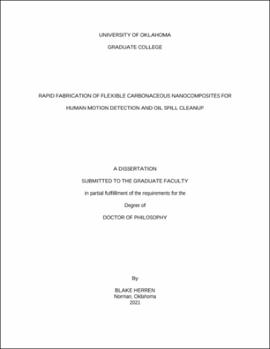| dc.description.abstract | In this work, flexible carbonaceous nanocomposites are fabricated via microwave irradiation, direct ink writing (DIW), and a porogen mixing method to develop multifunctional devices. A thermoset elastomer (silicone rubber), carbon nanotubes (CNTs), and carbon black (CB) are the primary materials used for samples in this work. The effects of microwave-curing in comparison to traditional thermal-curing of polydimethylsiloxane (PDMS) containing dispersed CNTs are explored. Microwave-curing proves to enhance the electrical conductivity of the lowest conductive loading of nanocomposites by almost 150 % due to CNT dispersion and alignment improvements. In addition, the rapid curing procedure reduces the curing time by at least 96 %, lowers the modulus, and unaffected the compressive piezoresistive sensitivity of the material. Ecoflex silicone rubber is used to develop skin-attachable sensors for human motion detection. A DIW method known as embedded 3D printing (e-3DP) is employed to fabricate these sensors and tailor the sensitivity. Nanocomposite PDMS sponges are fabricated by mixing the prepolymer with sugar or salt porogen. The sponge sensors demonstrate useful piezoresistive behavior and embedded nanofiller for safe skin-attachable human motion detection. A nanocomposite PDMS sponge material is also investigated as a reusable sorbent material for oil/water separation. The oleophilic, hydrophobic, durability, and Joule heating properties of the sorbent sponge material are optimized for use in a cutting-edge sorbent-based oil skimmer (SOS) that is developed for continuous removal of oil spills. The SOS is a floating vessel containing a funnel-shaped sponge for continuous and efficient gravity-driven extraction of oil from the water surface. The SOS is used to extract fish tank-scale simulated oil spills. This work explores the rapid microwave-based fabrication of carbonaceous elastomeric nanocomposites and develops strain sensing devices for human motion monitoring and oil sorbents for the efficient removal of oil spills from water. | en_US |
